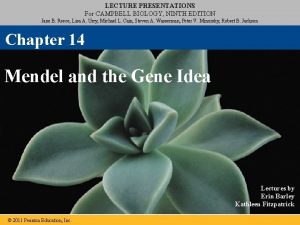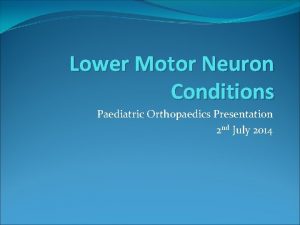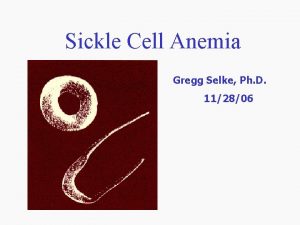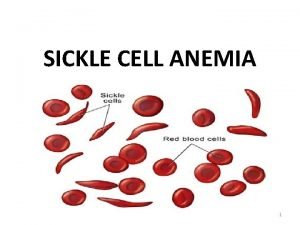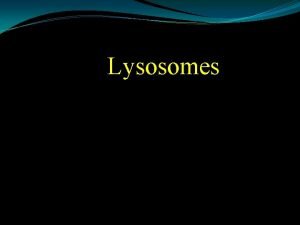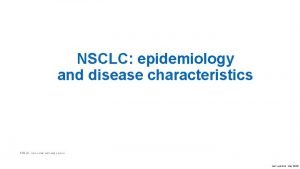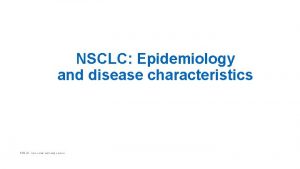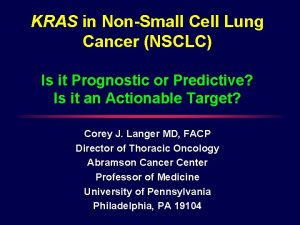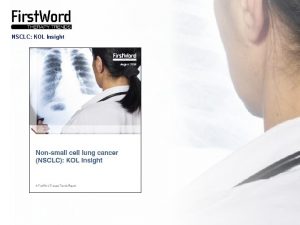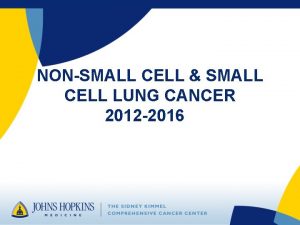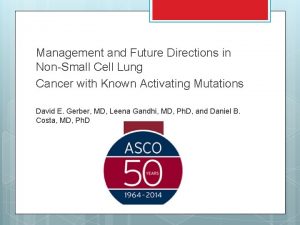NSCLC Epidemiology and disease characteristics NSCLC nonsmall cell















- Slides: 15

NSCLC: Epidemiology and disease characteristics NSCLC, non-small cell lung cancer.

Lung cancer incidence and mortality 1 One of the most common cancers, with 2 million new cases worldwide in 2018 Male 1. Bray F, et al. CA Cancer J Clin 2018; doi: 10. 3322/caac. 21492. [Epub ahead of print]. The most common cause of cancer death, causing nearly one in five of all cancer deaths worldwide in 2018 Female

Global distribution of lung cancer Global incidence and mortality rates 1 Male Micronesia Polynesia Central and Eastern Europe Eastern Asia Western Europe Southern Europe North America Western Asia Northern Europe Australia/New Zealand South-Eastern Asia Southern Africa Caribbean Melanesia Northern Africa South America South-Central Asia Central America Middle Africa Eastern Africa Western Africa 60 Female • In 2018, there were approximately 2, 094, 000 new cases of lung cancer worldwide; incidence is estimated to increase by 38% by 20302 • The geographical pattern of lung cancer incidence generally reflects historical patterns in tobacco use 3 40 20 40 60 • Temporal and geographical patterns of mortality mirror those of incidence owing to lung cancer’s high fatality rate (mortality-to-incidence ratio: 0. 87)3, 4 Age standardised rates (% per 100, 000) Incidence Mortality 1. International Agency for Research on Cancer, World Health Organization. http: //gco. iarc. fr/today/data/factsheets/cancers/15 -Lung-fact-sheet. pdf (Accessed: 24 April 2019). 2. International Agency for Research on Cancer, World Health Organization. http: //gco. iarc. fr/tomorrow/graphic-isotype (Accessed 24 April 2019); 3. International Agency for Research on Cancer, World Health Organization. http: //gco. iarc. fr/today/data/pdf/fact-sheets/cancer-fact-sheets-11. pdf (Accessed: 24 April 2019). 4. Wong MC, et al. Sci Rep. 2017; 7(1): 14300.

Survival rates for lung cancer are generally low Percentage (%) 5 -year survival trends for various cancers 1 Prostate Breast 100 90 80 70 60 50 40 30 20 10 0 Colorectal High unmet medical need 1975 1980 1985 1990 1995 2000 2005 2010 Lung 2015* Survival rates vary depending on stage at diagnosis. The later the stage of diagnosis, the lower the 5 -year survival rate 2 *Data for 2015 are predicted based on the modelled trend. . 1. National Cancer Institute Surveillance, Epidemiology, and End Results (SEER). https: //seer. cancer. gov/statfacts/ (Accessed: 07 December 2018 ). 2. Ridge CA, et al. Semin Intervent Radiol 2013; 30(2): 93– 8.

Stage of diagnosis affects 5 -year survival rate Almost 60% of patients with lung cancer have late-stage disease at diagnosis The 5 -year survival rate is low in patients with late-stage disease 1. National Cancer Institute Surveillance, Epidemiology, and End Results (SEER). https: //seer. cancer. gov/statfacts/html/lungb. html (Accessed: 07 December 2018).

Is there a ‘typical’ lung cancer patient? • Traditionally, the ‘typical’ lung cancer patient was thought to be an older male with a history of smoking • However, recent studies have demonstrated the trend is shifting: Lung cancer mortality in women, including young women in some countries, has been on the rise 1 -4 Reflecting changes in the relative incidence of lung cancer in women versus men, 5 there is a recent report that incidence may now be higher in young women than young men in the US 6 A higher proportion of lung cancer cases occur in never-smokers in Asian countries than in Western countries 7 In patients with adenocarcinoma histology, mutations in EGFR are more prevalent in Asian populations than elsewhere 8 EGFR, epidermal growth factor receptor; US, United States of America. 1. Malvezzi M, et al. Ann Oncol 2017; 28(5): 1117‒ 23. 2. Martin-Sanchez JC, et al. Cancer Epidemiol 2017; 49: 19– 23. 3. Martin-Sanchez JC, et al. Cancer Res 2018; 78(15): 4436– 42. 4. Levi F, et al. Int J Cancer 2007; 121(2): 462‒ 5. 5. Kozielski J, et al. Contemp Oncol (Pozn) 2012; 16(5): 413– 5. 6. Jemal A, et al, N Engl J Med 2018; 378(21): 1999– 2009. 7. Toh CK, Lim WT. J Clin Pathol 2007; 60(4): 337– 40. 8. Midha A, et al. Am J Cancer Res. 2015; 5(9): 2892‒ 911.

Tobacco use is the most important risk factor in lung cancer 1 Tobacco smoking is the most important cause of lung cancer Rates of lung cancer deaths Trends in lung cancer mortality rates in a Over the last few decades lung cancer mortality attributable to smoking vary from country generally follow trends in smoking rates in the EU have been decreasing in men but >80% in the US and France to 61% in prevalence, with lung cancer trends lagging increasing in women, reflecting a later decline in by 20– 30 years 1 smoking prevalence among women 1, 2 Asia and 40% in sub-Saharan Africa 1 Age-standardised EU male and female lung cancer mortality rates 2* *Mortality rate trends over five years from 1970‒ 1974 to 2005‒ 2009 plus the year 2012 and predicted rates for 2017. EU, European Union. 1. Islami F, et al. Transl Lung Cancer Res 2015; 4(4): 327– 38. 2. Malvezzi M, et al. Ann Oncol 2017; 28(5): 1117‒ 23.

There are two main types of lung cancer 1 85% 15% Non-small cell lung cancer (NSCLC) Small cell lung cancer (SCLC) NSCLC usually grows and spreads more slowly than SCLC 2 1. Zappa C & Mousa SA. Transl Lung Cancer Res 2016; 5(3): 288– 300. 2. Lozić AA, et al. Coll Antropol 2010; 34(2): 609– 12.

NSCLC is genomically diverse Histological distribution of NSCLC 1 Driver mutations in adenocarcinoma 2 ALK HER 2 BRAF PIK 3 CA AKT 1 MAP 2 K 1 NRAS ROS 1 RET EGFR KRAS Unknown Driver mutations in squamous cell carcinoma 2 NSCLC, non-small cell lung cancer. 1. National Cancer Institute. Surveillance, Epidemiology and End Results Program. https: //seer. cancer. gov (Accessed May 2019). 2. Li T, et al. J Clin Oncol 2013; 31(8): 1039– 49.

Irrespective of metastases 1– 3 Metastatic NSCLC 3, 4 Mortality rates are greatly improved when lung cancer is diagnosed early Worsening long-term cough Chronic cough Wheezing or shortness of breath Hoarseness Loss of appetite Weight loss Recurrent pneumonia Haemoptysis Fatigue Constant chest pain Recurrent bronchitis Symptoms may vary widely and often coincide with the site of tumour metastasis Common symptoms Some common NSCLC symptoms Lumps near the surface of the body (lymph nodes), often in the neck or above the collarbone Jaundice Dizziness Seizures Headaches Bone pain Bleeding or blood clots Weakness or numbness of the arms or legs NSCLC, non-small cell lung cancer. 1. Medline. Plus Medical Encyclopedia. http: //www. nlm. nih. gov/medlineplus/ency/article/007194. htm (Accessed: 07 December 2018). 2. Thomas KW. Up. To. Date. http: //www. uptodate. com/contents/lungcancer-risks-symptoms-and-diagnosis-beyond-the-basics (Accessed: 07 December 2018). 3. Web. MD. http: //www. webmd. com/lung-cancer-symptoms (Accessed: 07 December 2018). 4. American Cancer Society. http: //www. cancer. org/cancer/lungcancer-non-smallcell/detailedguide/non-small-cell-lung-cancer-signs-symptoms (Accessed: 07 December 2018).

Diagnostic workup of NSCLC: laboratory evaluation and imaging 1 Laboratory Standard tests, including routine haematology, renal and hepatic function, and bone biochemistry Radiology CT scan of chest and upper abdomen; complete assessment of liver, kidneys and adrenal glands CNS imaging (MRI [more sensitive] or CT scan with iodine contrast) if available; required in patients with neurological symptoms If bone metastases suspected: PET, ideally coupled with CT, and bone scans. PET/CT is most sensitive for detecting bone metastases. MRI as needed Assessment of mediastinal lymph nodes and distant metastases: FDG–PET/CT scan offers highest sensitivity CNS, central nervous system; CT, computed tomography; FDG, fluorodeoxyglucose; MRI, magnetic resonance imaging; PET, positron emission tomography. 1. Planchard D, et al. Ann Oncol 2018; 29(Suppl. 4): iv 192–iv 237.

NSCLC is most often diagnosed at an advanced stage Almost 60% of patients with lung cancer have late-stage disease at diagnosis 1 Early lung cancer may not cause any symptoms 2 25% 75% have no symptoms when lung cancer is diagnosed develop some symptoms 3 Many of the symptoms that do appear with more advanced disease can be mistaken for other illnesses 4 Early symptoms that may be difficult to notice include: Persistent cough Shortness of breath Dull and persistent pain in the chest Repeat infections, such as bronchitis or pneumonia NSCLC, non-small cell lung cancer. 1. National Cancer Institute Surveillance, Epidemiology, and End Results (SEER). https: //seer. cancer. gov/statfacts/html/lungb. html (Accessed: 07 December 2018 ). 2. Medline. Plus Medical Encyclopedia. http: //www. nlm. nih. gov/medlineplus/ency/article/007194. htm (Accessed: 07 December 2018 ). 3. Web. MD. http: //www. webmd. com/lung-cancer-symptoms (Accessed: 07 December 2018 ). 4. American Cancer Society. http: //www. cancer. org/cancer/lungcancer-non-smallcell/moreinformation/lungcancerpreventionandearlydetection/lung-cancer-prevention-and-early-detection (Accessed: 07 December 2018 ).

Lung cancer staging and TNM classification 1 • The most frequently used system to stage lung cancer is the American Joint Committee on Cancer TNM system, which is based on: – The size and extent of the primary tumour (T) – Whether the cancer has spread to nearby (regional) lymph nodes (N) – Whether the cancer has metastasised (M) to other organs of the body • Once the T, N and M categories have been defined, this information is combined to assign an overall stage of 0, I, III or IV • This process is called stage grouping • It produces a range of anatomical stage or prognostic groups (right) T 1 mi, minimally invasive adenocarcinoma; Tis, tumour in situ; TNM, tumour, node, metastasis. 1. American Joint Committee on Cancer. Lung cancer staging. 8 th ed. 2017. https: //cancerstaging. org/references-tools/Pages/Cancer-Staging-Resources. aspx (Accessed: 07 December 2018).

Lung cancer TNM classification explained 1 *There is no designation of MX. The absence of any clinical history or physical findings suggestive of metastases in a patient who has not undergone any imaging is sufficient to assign the clinical M 0 category. There is no designation of p. M 0. Biopsy or other pathological information is required to assign the pathological M 1 category. Patients with a negative biopsy of a suspected metastatic site are classified as clinical M 0 (c. M 0). c. M, clinical metastasis; p. M, pathological metastasis; TNM, tumour, node, metastasis. 1. American Joint Committee on Cancer. Lung cancer staging. 8 th ed. 2017. https: //cancerstaging. org/references-tools/Pages/Cancer-Staging-Resources. aspx (Accessed: 07 December 2018).

Summary • Lung cancer is one of the most common cancers, with ~2 million new cases worldwide in 20181 • There are two main types of lung cancer: SCLC and NSCLC 2, 3 – NSCLC usually grows and spreads more slowly than SCLC • NSCLC comprises adenocarcinoma and squamous cell carcinoma 4 – Major driver mutations in adenocarcinoma include EGFR and KRAS • The majority of patients with lung cancer have late-stage disease at time of diagnosis 5– 7 – The TNM system, is used for staging, taking into account the size and extend of the primary tumour (T), whether it has spread via the lymph nodes (N) or metastasised (M) – The 5 -year lung cancer survival rate is low in patients with late-stage disease NSCLC, non-small cell lung cancer; SCLC, small cell lung cancer. 1. Bray F, et al. CA Cancer J Clin 2018; doi: 10. 3322/caac. 21492. [Epub ahead of print ]. 2. Zappa C & Mousa SA. Transl Lung Cancer Res 2016; 5(3): 288– 300. 3. Lozić AA, et al. Coll Antropol 2010; 34(2): 609– 12. 4. Li T, et al. J Clin Oncol 2013; 31(8): 1039– 49. 5. National Cancer Institute Surveillance, Epidemiology, and End Results (SEER). https: //seer. cancer. gov/statfacts/html/lungb. html (Accessed: 07 December 2018). 6. American Joint Committee on Cancer. Lung cancer staging. 8 th ed. 2017. https: //cancerstaging. org/references-tools/Pages/Cancer-Staging-Resources. aspx (Accessed: 07 December 2018 ). 7. Ridge CA, et al. Semin Intervent Radiol 2013; 30(2): 93– 8.
 Domenico galetta
Domenico galetta Adjuvant nsclc
Adjuvant nsclc Nsclc
Nsclc Communicable disease and non communicable disease
Communicable disease and non communicable disease Difference between descriptive and analytical epidemiology
Difference between descriptive and analytical epidemiology Nutritional epidemiology definition
Nutritional epidemiology definition Descriptive vs analytical epidemiology
Descriptive vs analytical epidemiology Descriptive vs analytical epidemiology
Descriptive vs analytical epidemiology Certification board of infection control and epidemiology
Certification board of infection control and epidemiology Person place time epidemiology
Person place time epidemiology Gene therapy for sickle cell disease
Gene therapy for sickle cell disease Codominace
Codominace Anterior horn cell disease
Anterior horn cell disease Sickle cell anemia
Sickle cell anemia Sickle cell disease
Sickle cell disease I cell disease
I cell disease










